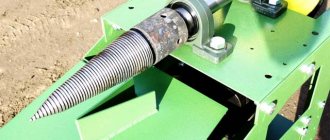Manufacturing options
Before you start manufacturing, you should decide on its purpose. Depending on this, in the future you can decide on the manufacturing technology. Based on this characteristic, the following manufacturing options are distinguished:
- without hardening . This method is suitable for making kitchen and household knives, the blade of which can be easily straightened using musat or a whetstone;
- using hardening . The use of metal hardening improves the strength characteristics of the blade, allowing the user to cut almost any material. The metal holds an edge longer, so this method is more acceptable when making camping and hunting knives.
A knife is a type of cold piercing and cutting weapon. Therefore, in order to avoid problems with the law, when manufacturing it is worth remembering that the length of the blade should not exceed 90 mm, and its thickness should not exceed 2 mm.
Sanding and varnishing a knife handle
Final sanding is done using sandpaper. Gradually increasing the grain size, it is necessary to remove all rough marks from paper of a larger grain size. It is enough to complete the process of sanding the knife handle with 600 grit paper. The last step in making the handle will be its impregnation.
There are several ways to impregnate a handle to better preserve it. This is oil impregnation, wax impregnation or varnish coating.
Each method has its own advantages and disadvantages. For example, wax must first be melted by heating it, and heating has a detrimental effect on the strength of the glue that glues the handle. Oils must be updated periodically. And the varnish serves only the function of surface protection.
How to make it yourself
Making a knife from a circular saw blade is not as difficult as it seems at first glance. Its manufacture does not require special technical skills or the use of special equipment. If you wish, you can do all the work yourself.
Deciding what we will do
First of all, you need to decide on the purpose, shape and size of the future product. The size of the saw blade used and the required set of tools for manufacturing will depend on these parameters.
For example, to make a hunting knife, it is best to use a 16-inch long concrete cutting blade. For the kitchen, a 12-inch wood saw blade is suitable.
What is needed for making
In addition to the drawing of the future product, to make a knife you will need the following materials and tools:
- saw blade;
- angle grinder with a set of discs;
- drill press or drill;
- drills for wood and metal;
- wooden block;
- sandpaper of various grain sizes;
- sanding block.
Disk selection
Almost all modern saw blades are made from high-carbon steel 9ХФМ. Products made from such material are practically resistant to corrosion and have a long service life. Therefore, choosing a saw blade for making a knife comes down only to the correct placement of the workpiece layout on the disk.
When choosing a high-quality disc, you can check its quality by ear. A good quality disc rings when you tap it, a dull sound is produced by a disc with internal defects.
Step-by-step manufacturing instructions
Before starting work, it is necessary to cut out a template for the future knife and clean the surface of the saw blade from dirt and traces of possible corrosion. In order to make a homemade knife, you must perform the following steps:
- Place the template on the surface of the saw blade and, securing it with magnets, apply markings.
- Using a grinder, cut out the workpiece. The cut must be made along the outer edge of the marking. To prevent overheating and changes in the properties of the metal, the saw blade should be watered with water during operation.
- Using a grinder with a grinding disc, rough the workpiece.
- Place 36-grit sandpaper on a belt sander and give the workpiece the required shape. Periodically it is necessary to dip the workpiece in a bucket of water to cool.
- Place 80 grit sandpaper on the machine and finish the workpiece.
- Clamp the workpiece between two wooden blocks and secure them with a clamp. One of the ends of the block should be at the beginning of the future butt.
- Without removing the stops, sharpen the knife blade.
- Periodically it is necessary to check the difference between the upper and lower ends of the future knife. If the butt thickness is 2 mm, the difference between them should not exceed 1 mm.
- After removing the wooden blocks, polish the shank of the knife by first moistening it with water.
- By installing a grinding wheel with a grain fraction of 240 on the grinder, polish the blade.
- Secure the workpiece to a wooden board using a clamp.
- After securing 400 and 1000 grit sandpaper to a wooden block, use a back-and-forth motion to finely polish the blade.
- Cut 7 mm thick wooden plates to make handles. Their length should correspond to the length of the knife shank.
- Mark the handles.
- Apply two-component epoxy resin to the inner surface of the wooden plates and attach them to the shank of the knife. After this, press them with a clamp.
- After the glue has dried, drill two through holes in the handle to install aluminum rivets.
- Install the rivets into the mounting holes and rivet them with a hammer.
- On a grinding machine, and then manually shape the handle into the desired shape.
- Cover the handles with stain and let it dry completely.
After this, you can dip the knife blade in a 5% nitric acid solution for several minutes to coat it with a protective oxide film. Then you need to thoroughly rinse the blade with running water and sharpen it.
After watching the video, you can see all the subtleties and nuances of making homemade knives from a saw blade, and also learn some ways to protect blades from corrosion.
Knife from a chainsaw chain
Saw chains are made of high-quality alloy, which perfectly withstands prolonged friction and high temperature. The blade manufacturing process is long and labor-intensive, but the result is a beautiful, unique and very durable knife. To work you will need a heavy anvil, barbecue and charcoal. To make it easier to handle a hot workpiece, you need to purchase blacksmith tongs.
Making a blade from a chainsaw chain should be carried out in the following sequence:
- Prepare clothes and gloves made of thick fabric and a protective mask. Pour charcoal into the fireplace and light it with a special liquid.
- Fold the workpiece from a single piece of chain. In the place where the handle will be, you can add several pieces of chain. It should be remembered that the result of the work should be a single monolithic product. The handle for the knife is not made separately.
- Place the workpiece on the coals. Provide air flow to raise temperature. Wait until the steel turns dark red. In this state, it becomes forgeable without losing its quality characteristics.
- Remove the hot chain from the fire and place it on the anvil. Flatten it with several strong blows so that the links melt together, turning into a single monolithic part.
- Step by step, by heating the workpiece in the oven and giving it the desired shape with a hammer, forge a knife with a designated handle and blade. After the workpiece has cooled, sharpen and polish it.
- Harden the product. To do this, you need to heat it red-hot again and put it in cold water. After this, you can finish the knife. For this purpose, acid and an engraving machine are used. The finished blade is polished again and washed in a warm soapy solution.
When making a blade yourself, you must adhere to certain parameters so that the finished product does not fall under the category of edged weapons.
Does such a blade need hardening or can it be done without it?
The blade is hardened depending on the application of the knife. If it is used at home for cutting food, then hardening is not necessary. In this case, the strength characteristics of the metal are quite sufficient.
If the knife will be used on hikes for chopping trees and cutting other materials, it is necessary to harden the blade. This will improve the strength and hardness of the blade, and it will also hold an edge better.
We also recommend reading an interesting article on how to make a hole drill from a circular saw disc.
Shank drilling
The handle on the shank can be secured with rivets or glue. The most reliable option for attaching the handle is to use rivets. To install them, you need to make holes in the shank. The holes are marked on the shank so that they are located approximately in the middle of the future handle. To prevent the drill from slipping at the initial stage of drilling, the holes are cored.
Due to the fact that the circular saw is made of alloy tool steel, drilling it will not be so easy. Ordinary metal drills will not last long here.
Drilling should be done with cobalt drills or a ceramic drill with a pobedite tip.
During the drilling process, it is important to add oil to the drilling area and not allow the drill to overheat.
Drilling through hardened steel is quite a difficult task. Therefore, it is possible to produce holes in the shank using an electrochemical method. To do this, attach a wire to the workpiece, then completely cover the shank with bitumen mastic or plasticine. In areas of future holes, the protective layer is scratched down to bare metal. Next, a saturated solution of table salt is prepared, into which the blade shank with a wire and an unnecessary metal plate, also with a wire, are dipped. Both wires connect to the battery or car charger. A “plus” is applied to the future knife from a circular saw, and a “minus” is applied to the plate. The etching process is accompanied by the release of gas. In 30–50 minutes the holes will be ready.
Example drawings
On the Internet you can find a huge number of different drawings of blades of the most varied shapes and different purposes.
The diagram below shows a popular knife model with a long blade. It is suitable for lovers of active recreation, hunting and fishing.
In addition, from the saw blade of a circular saw you can make a kitchen knife with a long blade, which is ideal for cutting meat and offal and will become an indispensable assistant in the kitchen.
Working tools and materials
The raw material for creating a handicraft knife can be any used or new cutting component made of hardened steel. As a semi-finished product, it is advisable to use saw wheels for metal, concrete, saw wheels for pendulum end saws and hand saws. A decent material would be a used gasoline saw. From its chain it is possible to forge and make a blade, which in its properties and appearance will be no worse than the legendary Damascus blades.
To create a knife from a circular disk with your own hands, you will need the following equipment and materials:
- angle grinder;
- emery machine;
- electric drill;
- ruler;
- hammer;
- sandpaper;
- whetstones for sharpening;
- files;
- center punch;
- epoxy;
- copper wire;
- felt-tip pen;
- container with water.
To create a handle, it is preferable to use:
- non-ferrous alloys (silver, brass, bronze, copper);
- wood (birch, alder, oak);
- plexiglass (polycarbonate, plexiglass).
The material for the handle must be solid, without cracking, rottenness or other defects.
Vacation
After hardening, the blade must be released. This procedure is carried out with the aim of reducing fragility, as well as giving the saw blade high elasticity. To temper, the blade is cleaned with sandpaper to remove scale formed during the hardening process and placed in a regular oven preheated to 190 degrees. There the blade is kept for an hour, then the oven heating is turned off.
The knife should cool smoothly to room temperature.
After this procedure, the workpiece has the necessary hardness and elasticity.
Releasing the blade in the oven











